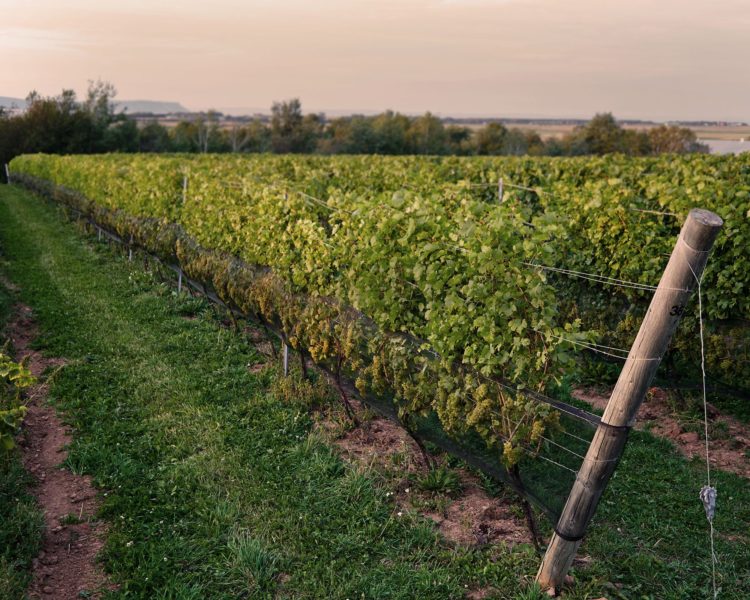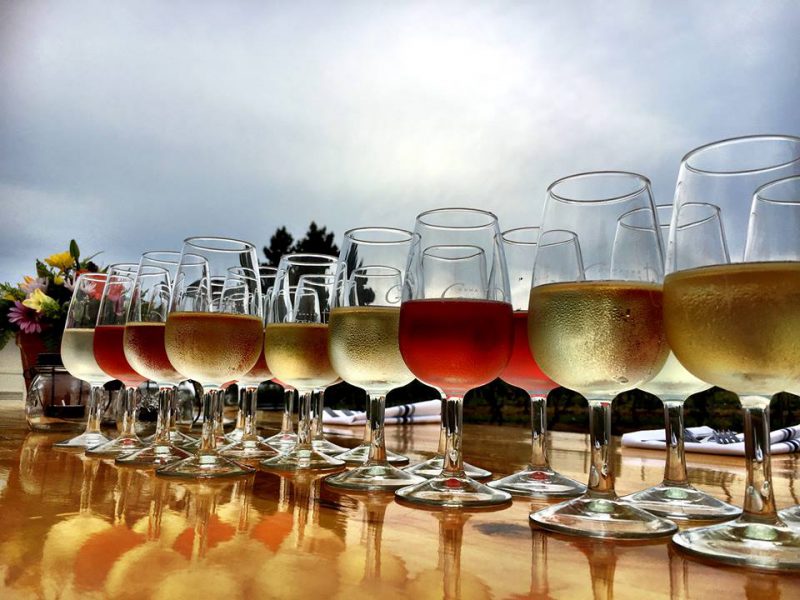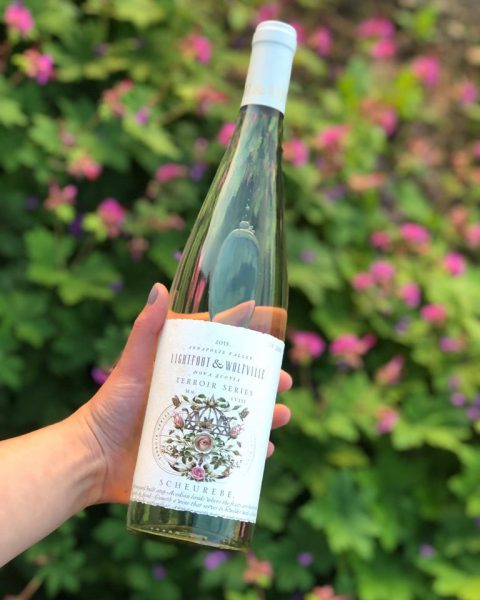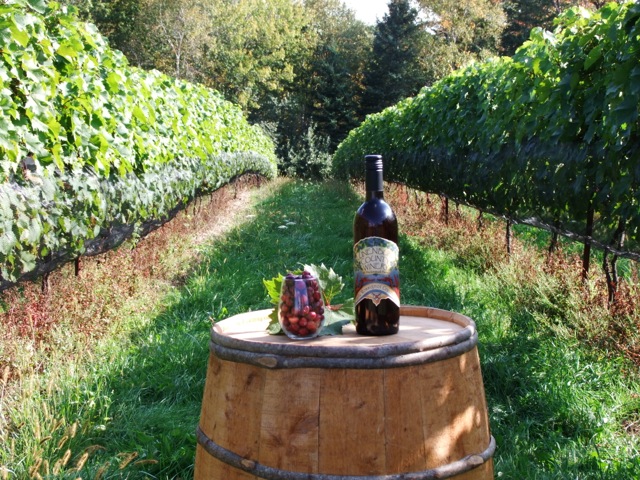Nova Scotia Wine 101

Dating back to 1611, when French settler Louis Hébert planted a small vineyard in Bear River, wine has had a long and rich history in Nova Scotia. Because of its soil (a mixture of sandstone and slate soil) and microclimates, our province is home to distinct and high-quality grapes, allowing the effect of the Atlantic Ocean to give us vineyards like no other. In fact, in Nova Scotia, our vineyards are never more than 20 km from the ocean – the vines actually grow in the remains of an ancient seabed!
Our cool nights also offer an advantage, as it preserves grape acids – acidity is a signature attribute of Nova Scotia wine. Never duplicated naturally anywhere else in the world with the same intensity that our Nova Scotia climate creates, this acidity helps balance the sugar in white wines and adds a spark of life. It’s naturally Nova Scotian.
Grape Varieties

The L’Acadie Blanc grape is one of the major players in producing our well-known white wines. This variety was originally created in Ontario but is most notably found in Nova Scotia. It produces a pale yellow wine that has crisp acidity and a lengthy finish with notes of citrus and grass. It’s often barrel aged because of its medium acidity and is best paired with rich foods such as lobster or alfredo pasta.
Also playing a major role in our province’s white wines are Seyval Blanc, Vidal Blanc, and Geisenheim 318, however, Chardonnay, Riesling, and Sauvignon Blanc are also up and coming varietals in Nova Scotia, among others.
When it comes to red wine, Marechal Foch, Leon Millot, Lucie Kuhlmann, and Baco Noir often play a role in red wine production, however, grapes like Castel and Pinot Noir, among others, can also be found.
Wine Lingo

Here are some common terms you might hear during your next wine tasting:
Terroir: How a region’s climate, soil and terrain affect the taste of wine.
Acidity: A wine’s tartness and what makes it so refreshing and crisp. A leading determinant of balance.
Body: Describes the overall weight, fullness or feel of the wine. Full bodied wines are big and powerful, whereas light bodied wines are more delicate and lean.
Tannins: A natural compound from the skins, stems and seeds of the grapes used to produce the wine. The dryer the wine feels, the more tannins it contains.
Earthy: A term used to describe an aroma or flavour of a wine, such as the smell of fresh earth, cultivated soils, herbs or root vegetables!
Dry: Simply a wine that has no (or less than 0.2 per cent) residual sugar. The opposite of sweet!
Finish: The last impression of a wine. This is the taste that stays on the palate after the wine has been swallowed.
Complexity: The blending of different grapes, barrel fermentation and aging are all components in making a wine more complex. The more that goes into it, the more complexity it gains!
Sparkling

The traditional-method sparkling wines we create in Nova Scotia are attracting worldwide attention and comparisons to Champagne in terms of quality. What makes Nova Scotia bubbles truly stand out is the mouth-watering acidity created naturally in our cool climate. Gordon Ramsay even has a bottle of traditional-method sparkling wine on the menu at one of his restaurants!
But what is a traditional-method sparkling wine? It’s simply sparkling wine that was bottle fermented. This means the wine went through its second fermentation, producing bubbles, in the bottle.
Pairing: Sparking wine is very food friendly, as it pairs with chicken, seafood, salad and dessert. It’s also delicious on its own!
White Wine

Our white wine is typically crisp and aromatic. We’re known for our signature Tidal Bay, our very own appellation wine, and often use popular hybrids such as L’Acadie Blanc, Seyval Blanc, Vidal Blanc, Geisenheim 318 and New York Muscat. Other popular varieties that you might see are Chardonnay, Ortega and Riesling. Lighter whites feature flavours of apple and pear with crisp acidity whereas fuller bodied whites have favours of vanilla and spice.
Pairing: Almost all white wines go with pasta and seafood, but if you’re drinking a fuller bodied wine pair it with rich, high protein and textured foods such as avocado, risotto and white fish. For sweeter wines, pair them with spicy food. The sugar and acidity will pair perfectly to balance out the heat!
Red Wine

Due to their cooler climate and relatively short growing season, growing the perfect red in Nova Scotia can be challenging. That being said, there are many grapes that actually grow very well here, lucky us! Varietals that you’re likely to see are Lucie Kuhlmann, Baco Noir, Marehal Foch and Leon Millot. These grapes produce well-rounded, full bodied and dry red wines with low tannins. Their taste profile is typically earthy, smoky and has berry characteristics.
Pairing: Red wine typically pairs well with a variety of different foods because of their moderate tannins and acidity. Light reds pair with roast turkey or salad, whereas heavier, full bodied wine pairs with traditional Nova Scotia stews, red meat or rich dishes.
Fruit Wine

It’s no secret that Nova Scotia is well known for its fruit, so it should be no surprise that we have fruit wine! The taste profiles are often bold and have an equal balance of acidity combined with fresh flavour. Fruit wine is popular in cooler climates because it matures faster with multiple harvesting periods and has three main styles: sparkling, fortified and ice.
Pairing: Sharp cheeses, light salads or desserts.
Icewine

True to its name, icewine is made from frozen grapes and can only be harvested at night between November and December, when the temperature is resting between -8 C and -10 C. After a very cool and slow fermentation, the result is a complex and full bodied dessert wine. Similar to most of our wines, the taste profile has a balanced acidity and flavour. Common varieties are Vidal, Ortega and New York Muscat.
Pairing: Dessert or on its own as an after dinner beverage.
Curious about learning even more about Nova Scotia’s wine industry? Make sure to visit the Nova Scotia Winery Association at www.winesofnovascotia.ca for facts, history, and more specific details.
–
For more of our Taste of Nova Scotia events, news and recipes delivered directly to your inbox, subscribe to our Taste of Nova Scotia emails.
